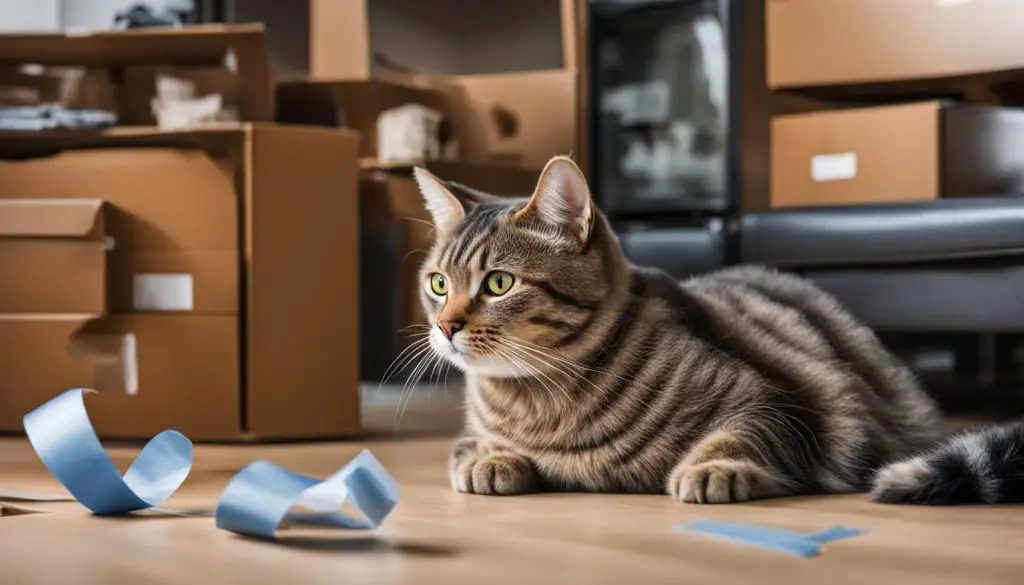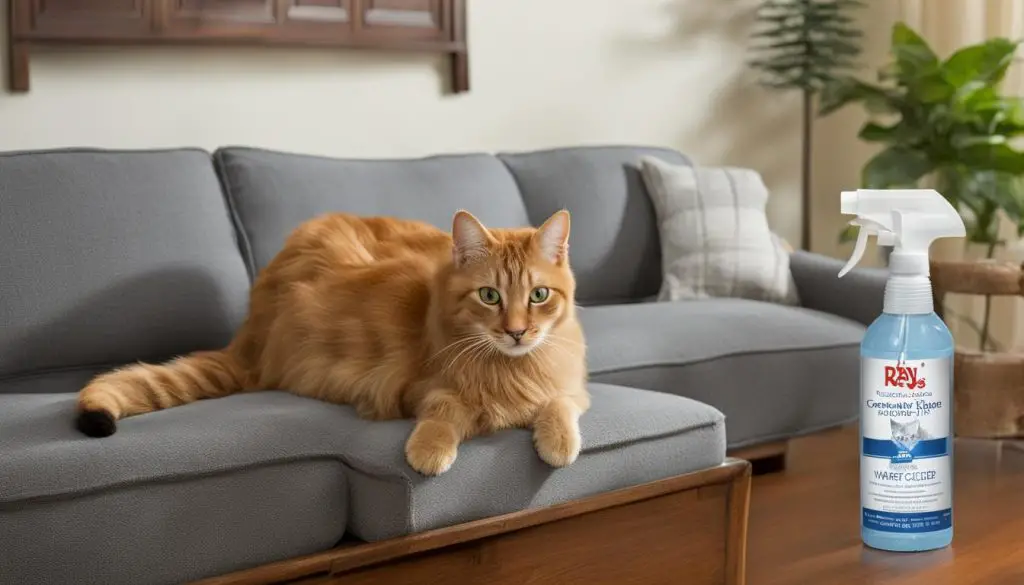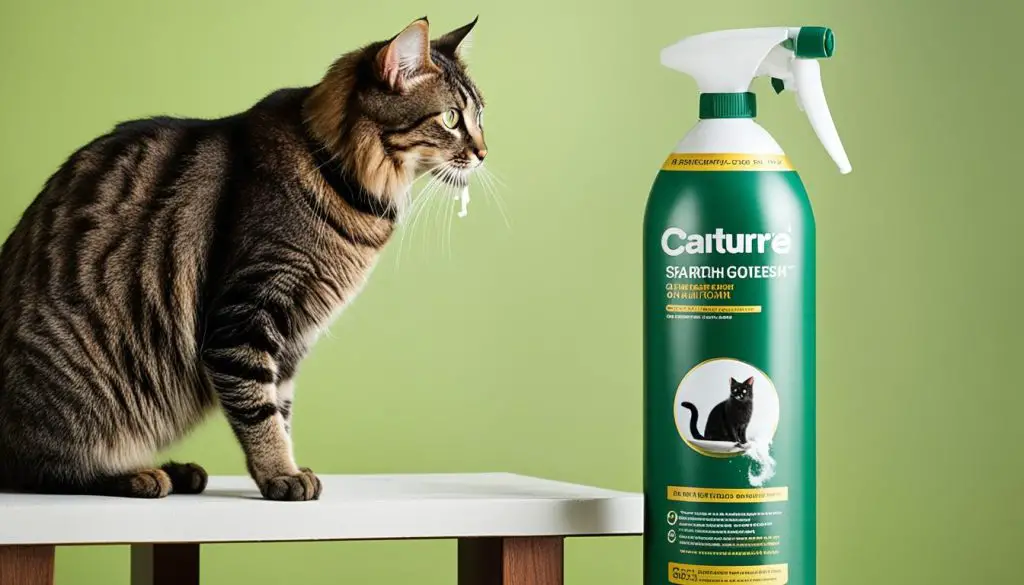Cats scratching furniture can be a frustrating and destructive behavior that many cat owners struggle with. Yelling and scolding the cat is ineffective and can strain your bond with them. Fortunately, there are effective home remedies that can help redirect your cat’s scratching behavior and protect your home furniture.
In this article, we will explore various home remedies and techniques that can be used to address this issue and prevent damage to your home furniture. From simple solutions like covering furniture with protectors to more elaborate approaches like limiting access to certain areas, we will provide practical steps and tips to help you find the most suitable solution for your cat.
Key Takeaways:
- Yelling and scolding your cat is ineffective in stopping them from scratching furniture.
- Trimming your cat’s nails can help minimize the damage caused by scratching.
- Providing a scratching post or scratcher offers an appropriate outlet for your cat’s natural scratching behavior.
- Using double-sided sticky tape or deterrent sprays can discourage your cat from scratching furniture.
- Covering furniture with protectors such as aluminum foil or plastic can act as a temporary deterrent.
Trim Claws

Trimming your cat’s claws is an essential first step in preventing them from scratching furniture. Cut nails are less sharp and cause less damage. Use a cat nail clipper set to trim the nails, making sure not to cut them too short to avoid pain or drawing blood. Watching tutorials or seeking professional grooming advice can help if you’re unsure how to trim nails.
Why Trim Your Cat’s Claws?
Trimming your cat’s claws is an important aspect of cat care that promotes both their well-being and the protection of your furniture. By keeping their claws trimmed, you can effectively prevent damage from cat scratches while ensuring your cat remains comfortable and happy.
Regular trimming of your cat’s claws offers numerous benefits:
- Reduced damage to furniture: Trimmed nails are less likely to snag on upholstery, reducing the risk of your cat scratching and causing unsightly damage to your furniture.
- Less risk of injury: When nails are cut, the sharp tips are removed, minimizing the chances of accidental scratches to you, other pets, or children.
- Enhanced comfort: Overgrown claws can cause discomfort and lead to paw and joint issues. Trimming them maintains your cat’s overall paw health and mobility.
When trimming your cat’s claws, it’s vital to use the right tools to ensure a safe and successful grooming experience. To choose your cat’s nail cutter, here are a few things to consider:
- Sharp stainless steel blades that effortlessly cut through nails
- Ergonomic handles for a comfortable grip during use
- A safety guard to prevent overcutting or injuring your cat
- Adaptability for handling different nail sizes
Step-by-Step Guide to Trimming Your Cat’s Claws
To help you successfully trim your cat’s claws, follow these simple steps:
- Gather all necessary supplies: cat nail clippers, treats for rewards, and a calm and quiet environment.
- Get your cat accustomed to handling and inspecting their paws by gently touching and stroking them daily. This will help them feel more relaxed during the trimming process.
- Choose a comfortable position for both you and your cat. You can place your cat on a secure surface, such as your lap or a table.
- Gently press your cat’s paw pad to extend the claws.
- Identify the translucent area of the nail called the “quick.” Carefully avoid cutting into the quick to prevent pain and excessive bleeding.
- Position the cat nail clippers around the nail, slightly above the quick, and make a quick, clean cut at a 45-degree angle.
- Repeat the process for each claw, taking breaks if necessary to keep your cat calm and comfortable.
- Remember to reward your cat with treats and praise after each successful trimming session.
Provide a Scratching Post or Scratcher
Redirecting your cat’s scratching behavior is crucial in preventing furniture damage. A scratching post or scratcher can serve as an excellent alternative for your feline friend. Various options are available in the market, including traditional scratching posts and flat scratchers designed specifically for cats that prefer scratching carpets.

It’s important to choose a scratching post or scratcher that your cat will enjoy and feel comfortable using. Keep in mind that cats may take some time to warm up to a new scratching surface. Be patient and encourage your cat to explore and engage with the post or scratcher.
One highly recommended option is the Hepper Hi-Lo Modern Cat Scratcher. It is constructed with sturdy cardboard and features a durable frame that withstands rigorous scratching. The scratcher also offers adjustable positions, allowing your cat to find the perfect angle and level of engagement.

Providing a scratching post or scratcher not only satisfies your cat’s natural urge to scratch but also helps prevent furniture damage. See the image below for an example of the Hepper Hi-Lo Modern Cat Scratcher:
Double-Sided Sticky Tape
Keeping Cats at Bay with Sticky Tactics
If you’re tired of finding your furniture shredded by your beloved feline friend, double-sided sticky tape could be the solution you’ve been looking for. Cats have an innate dislike for the feeling of stickiness on their paws, making sticky tape an effective cat deterrent.
To protect your furniture, apply double-sided sticky tape on areas where your cat likes to scratch. The sticky surface will discourage them from engaging in destructive behavior and redirect their attention to more appropriate scratching surfaces.

While the use of sticky tape is an effective method, it’s important to consider its limitations. This approach may not be suitable for items you need to use regularly or visible areas of your home, as the tape can leave residue and may not be aesthetically pleasing.
However, for hidden corners or less frequently used furniture, double-sided sticky tape can be an excellent temporary deterrent that helps protect your cherished belongings.
| Pros | Cons |
|---|---|
|
|
Spray – Water, Apple Cider Vinegar, and Citrus
Another effective method to deter cats from scratching furniture is by using sprays. Cats dislike certain smells and sensations, so utilizing sprays can help discourage their unwanted behavior. Here are three types of sprays that can be used as cat deterrents: water spray, apple cider vinegar spray, and citrus spray.
Water Spray
Water spray is a simple yet powerful deterrent for cats. Most cats dislike water and will try to avoid it. By using a spray bottle filled with clean water, you can give a quick spritz near your cat when they misbehave or scratch furniture. This gentle spray of water will startle them and make them associate their behavior with an undesirable outcome. Over time, they will learn to associate scratching furniture with the unpleasant experience of being sprayed with water.
Apple Cider Vinegar Spray
Apple cider vinegar has a strong scent that cats find repulsive. By combining equal parts clean water and apple cider vinegar, you can create a homemade cat deterrent spray. Fill a spray bottle with this mixture and apply it to areas where your cat tends to scratch furniture. The smell of apple cider vinegar will discourage them from approaching and scratching those areas. Be mindful not to spray the vinegar directly on the cat, as it can irritate their skin and eyes.
Citrus Spray
Cats have a natural aversion to the smell of citrus fruits such as lemons and oranges. You can make a homemade citrus spray by simmering lemon or orange peels in water. Allow the mixture to cool and then pour it into a spray bottle. Spray the citrus solution on the furniture or areas where you want to deter your cat from scratching. The scent of citrus will help deter them from approaching and scratching those surfaces.
It’s important to note that while these sprays are effective deterrents, essential oils should not be used as they can be harmful to cats. Stick to natural homemade sprays and avoid any potentially toxic substances.
Also read: How to Decorate a Nursing Room in Your Home

Cover Furniture with Aluminum or Plastic Protectors
If other methods fail to prevent cats from scratching furniture, covering the furniture with aluminum foil or plastic protectors can be a temporary solution. Cats dislike the feeling of aluminum foil, and plastic covers are easier to keep in place, providing full coverage for the furniture.
Aluminum foil can act as a deterrent due to its texture and sound. When cats come into contact with the foil, they often find it unpleasant and choose to avoid scratching the furniture altogether.
Plastic covers, on the other hand, offer a smooth surface that cats are less likely to scratch. These covers can be easily placed over the furniture and secured in place, providing a protective barrier between the cat’s claws and the furniture’s surface.

When using aluminum foil or plastic protectors, it is essential to ensure that they are securely attached and cover the entire furniture piece. Cats may find ways to bypass partial coverings, defeating the purpose of the protection.
Here are the pros and cons for protective foils and plastics:
| Advantages | Disadvantages |
|---|---|
|
|
|
|
It is important to remember that these solutions are temporary and should be combined with other methods, such as providing a scratching post or redirecting their behavior, for long-term results.

Limit Access
If all else fails, limiting access to the room where the furniture is located can be an effective strategy to prevent cats from scratching. By restricting their access, you can minimize the chances of your cat reaching the furniture they want to scratch.
To limit access, consider placing obstacles such as boxes or furniture in the way. These physical barriers can deter your cat from reaching the furniture and redirect their attention elsewhere. Ensure that the obstacles are strategically positioned to block the cat’s path and prevent them from scratching the furniture.
However, it’s important to ensure that the room can still be accessed by humans if a complete closure is not possible. Make sure there is a clear pathway for you and other family members to navigate through the room without any inconvenience.
Remember, limiting access is a temporary solution and should be used in conjunction with other methods to address the root cause of the scratching behavior.

Conclusion
Cats scratching furniture is a common issue that many cat owners face. However, by implementing the strategies we provide, you can maintain the beauty of your furniture while ensuring your cat’s well-being.
Remember, declawing is not recommended as it is a painful procedure and can result in long-term health issues for your cat. Instead, opt for these home remedies to address the issue and promote a happy and scratching-free environment for both you and your feline companion.
FAQ
How can I stop my cat from scratching the furniture?
There are several home remedies you can try to prevent your cat from scratching the furniture. These include trimming their claws, providing a scratching post or scratcher, using double-sided sticky tape, spraying water or citrus solutions, covering furniture with aluminum or plastic protectors, limiting access to certain areas, and gently scolding or redirecting their behavior. Declawing is not recommended.
How do I trim my cat’s claws?
Trimming your cat’s claws is an essential step in preventing them from scratching furniture. Use a cat nail clipper set to trim the nails, being careful not to cut them too short.
What should I provide my cat with to redirect their scratching behavior?
It’s important to supply your cat with a scratching post or scratcher. There are various types available, including traditional posts and flat scratchers for cats that prefer scratching carpets.
How can double-sided sticky tape help prevent cats from scratching furniture?
Double-sided sticky tape can be a great deterrent as cats dislike the feeling of stickiness on their paws. Apply it to areas where your cat likes to scratch, and they will avoid it.
Are there any spray solutions that can deter cats from scratching furniture?
Yes, you can spray water on your cat when they misbehave as most cats dislike water. Another spray solution can be made by combining equal parts clean water and apple cider vinegar. Cats also dislike the smell of citrus, so a homemade citrus spray made by simmering lemon or orange peels in water can be effective.
How can I protect my furniture from cat scratches?
Covering furniture with aluminum foil or plastic protectors can be a temporary solution to prevent cats from scratching. Cats dislike the feeling of aluminum foil, and plastic covers are easier to keep in place and cover the entire furniture piece.
What can I do to limit my cat’s access to furniture?
Placing obstacles such as boxes or furniture in the way can prevent the cat from reaching the furniture they want to scratch. Ensure the room can still be accessed by humans if complete closure is not possible.
What are some effective home remedies to stop cats from scratching furniture?
To prevent cats from scratching furniture, you can try trimming their claws, providing a scratching post or scratcher, using deterrent sprays or tape, covering furniture with aluminum or plastic protectors, limiting access, and redirecting their behavior through scolding or positive reinforcement.






